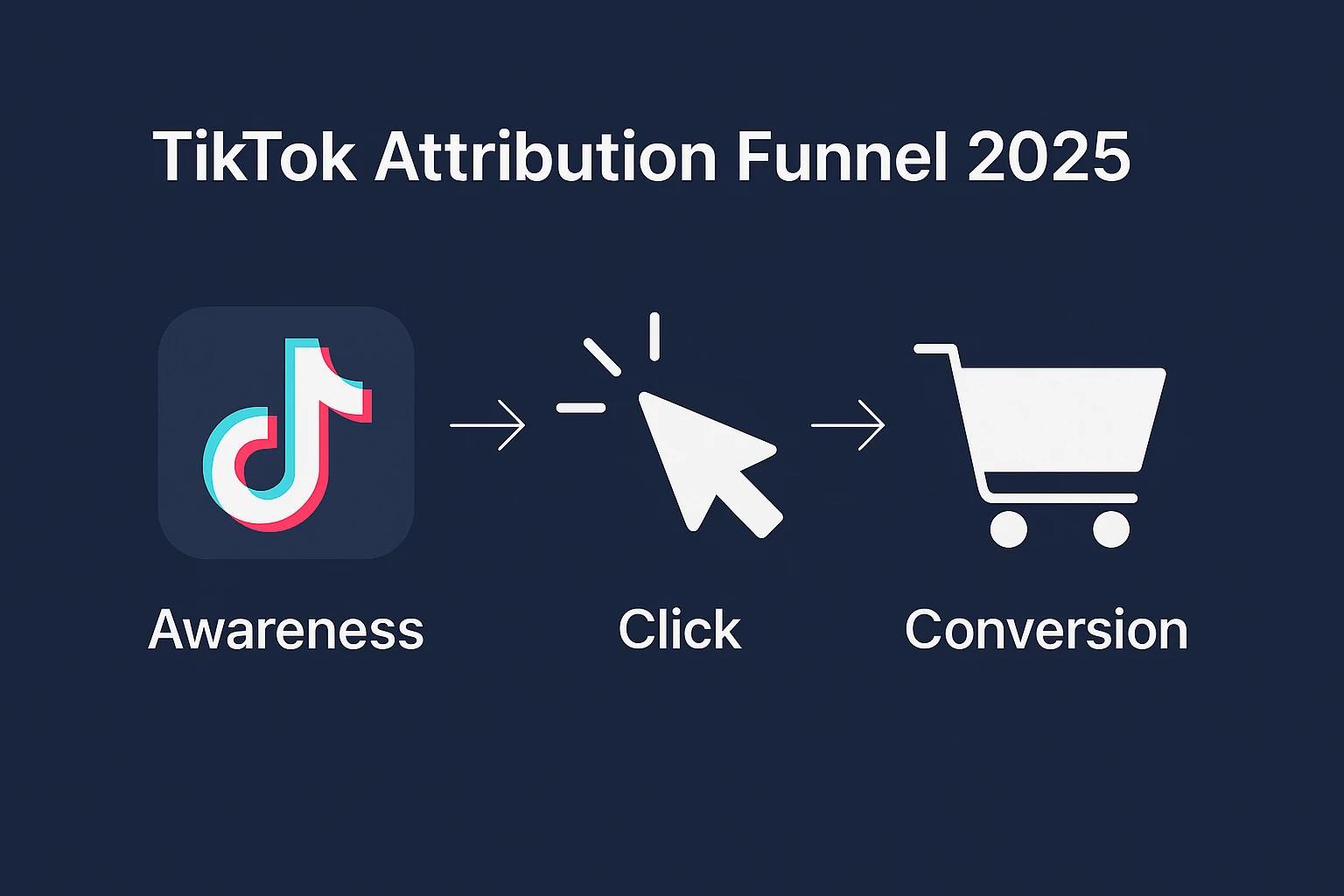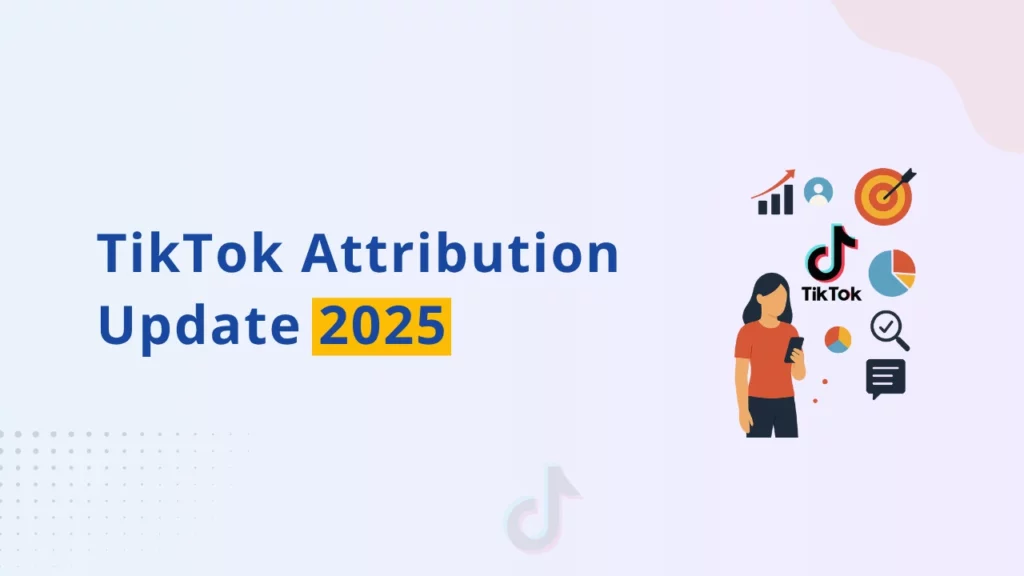TikTok is no longer just a discovery platform. In 2025, it has become a major growth channel for eCommerce brands. However, how success is measured on TikTok has changed. If you’re still relying on last-click data or basic pixel tracking, your results may be inaccurate.
TikTok’s new attribution system is built for better accuracy and compliance with privacy regulations. This guide explains what changed, how it impacts your campaigns, and what you can do to get accurate results and stronger returns.
TikTok’s attribution updates are designed to help advertisers better understand and optimize performance in a privacy-centric environment.
What’s New in TikTok Attribution in 2025?
TikTok made several updates to improve how conversions are tracked. These changes are designed to keep up with privacy regulations, browser restrictions, and the shift toward first-party data.

1. New Default Attribution Window
TikTok now uses a default attribution window of 7-day click and 1-day view. This means a conversion is recorded if a user clicks your ad and purchases within seven days, or views your ad and purchases within 24 hours.
This shorter window better reflects modern buyer behavior and avoids inflated ROAS.
Advertisers can configure click-through attribution windows of 1, 7, or 14 days and view-through attribution windows of 1 day within Attribution Manager.
2. Events API for Server-Side Tracking
TikTok’s Events API allows advertisers to send conversion data directly from their servers.
It works alongside the pixel to capture more events, especially when cookies are blocked or limited. Using server-side tagging ensures broader data coverage and more reliable attribution.
TikTok Events API enables advertisers to send web and offline events directly from their servers to TikTok, helping recover data lost to cookie restrictions or browser limitations.
This method is playing a major role in improving conversion tracking accuracy.
3. Advanced Matching with First-Party Data
With hashed user information like emails or phone numbers, TikTok can better match events to users, even if they switch devices or use private browsers.
This improves attribution accuracy and helps build stronger retargeting audiences. Implementing solid first-party data strategies reduces reliance on third-party cookies and increases long-term tracking reliability.
4. Full-Funnel Visibility for TikTok Shop and Live Ads
If you sell products using TikTok Shop or run live shopping campaigns, you can now track the entire funnel. From video views to product clicks to completed purchases, TikTok’s attribution tools provide clearer insights across each step of the journey.
Why These Changes Matter for Your Business
Accurate attribution helps you make smarter decisions. These updates improve campaign measurement in ways that directly impact performance:
- Improved ROAS tracking: Shorter attribution windows reflect real user behavior and reduce inflated results.
- More complete conversion data: Server-side tracking captures actions that the browser pixel might miss.
- Stronger audience targeting: With better data matching, your retargeting and lookalike campaigns become more effective.
- Cross-device accuracy: You can now track a user who views your ad on one device and converts on another.
However, these improvements also mean that reported ROAS may look lower than before. That’s not a drop in performance—it’s a more accurate picture.
How to Set Up Accurate TikTok Attribution in 2025
Here are the recommended steps to take:
1. Combine Pixel and Events API
![]()
Use both the browser pixel and server-side Events API. This hybrid setup ensures you track both on-page actions and conversions that happen after cookies are dropped or blocked. If you’re using Shopify, try the TikTok Pixel for Shopify app to simplify integration and improve tracking accuracy.
2. Share First-Party Data Securely
Upload hashed customer data, such as emails and phone numbers, to improve match rates. This helps TikTok connect ad interactions with conversions more effectively.
3. Review Attribution Window Settings
Use TikTok Attribution Manager to select the window that best fits your sales cycle. You can choose from 1, 7, or 14-day click windows. Start with the 7-day default and test adjustments over time. Be aware that ad tracking limitations caused by browser settings or user privacy preferences may affect window selection.
4. Monitor Funnel Performance
For brands using TikTok Shop or live shopping ads, check funnel reports inside TikTok Ads Manager. This helps identify where users drop off and where you can improve conversions.
Final Thoughts
Attribution is one of the most important parts of running profitable ad campaigns. TikTok’s updates in 2025 are a major step forward in helping brands understand what works, what converts, and how to grow.
If you want to scale your TikTok campaigns, now is the time to switch to a hybrid tracking setup, prioritize first-party data, and test attribution windows that reflect your customer journey.
Better tracking leads to better results and that starts with getting your attribution right.
Frequently Asked Questions
Q. Can I change the attribution window in TikTok?
Yes. TikTok allows 1, 7, or 14-day click windows and 1-day view windows. These can be managed inside Attribution Manager.
Q. Is TikTok Pixel enough on its own?
No. The pixel alone misses many conversions due to cookie restrictions. Combine it with the Events API for complete tracking.
Q. Do I need technical skills to set this up?
Some setups require server access or integration tools. You can work with a developer or use a tracking solution that supports TikTok’s Events API.
Q. Does this apply only to TikTok Shop ads?
No. These changes affect all types of TikTok advertising, but TikTok Shop and live ads now offer deeper funnel insights as well.

